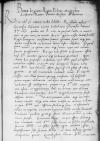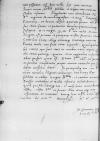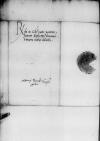Reddidit nobis generosus Achatius von Zehmen (Achacy Cema) (*ca. 1485 – †1565), 1517-1531 Chamberlain of Pomerania, 1531-1546 Castellan of Gdańsk (Danzig), 1545-1546 Voivode of Kulm (Chełmno), 1546-1565 Voivode of Marienburg (Malbork) (SBPN 1, p. 194-195; ORACKI 1984, p. 38-39; Urzędnicy 5/2, p. 198; PSB 4, p. 325-326)⌊Achatius CzemaAchatius von Zehmen (Achacy Cema) (*ca. 1485 – †1565), 1517-1531 Chamberlain of Pomerania, 1531-1546 Castellan of Gdańsk (Danzig), 1545-1546 Voivode of Kulm (Chełmno), 1546-1565 Voivode of Marienburg (Malbork) (SBPN 1, p. 194-195; ORACKI 1984, p. 38-39; Urzędnicy 5/2, p. 198; PSB 4, p. 325-326)⌋ castellanus Gdanensis cf. Ioannes DANTISCUS to Bona Sforza before 1540-11-16, CIDTC IDL 7299, letter lost⌊litterascf. Ioannes DANTISCUS to Bona Sforza before 1540-11-16, CIDTC IDL 7299, letter lost⌋ Paternitatis Vestrae, quibus nos Paternitas Vestra in praesenti luctu ac maerore nostro, in quo nunc ex morte serenissimi generi nostri, domini John Zápolya (János Szapolyai) (*1487 – †1540), 1526-1540 King of Hungary; son of István Szapolyai and Jadwiga of Cieszyn in 1540 married Isabella, dauther of of King Sigismund Jagiellon of Poland. He fought against Ferdinand of Habsburg for the right to the title of King of Hungary⌊Ioannis regis HungariaeJohn Zápolya (János Szapolyai) (*1487 – †1540), 1526-1540 King of Hungary; son of István Szapolyai and Jadwiga of Cieszyn in 1540 married Isabella, dauther of of King Sigismund Jagiellon of Poland. He fought against Ferdinand of Habsburg for the right to the title of King of Hungary⌋, constitutae sumus, graviter simul atque prudenter consolando medicinam dolori nostro adhibet. Id quod Paternitatem Vestram ex optimo suo atque sincero erga nos animo facere perspicimus.
Pro quo tam fideli ac humano officio Vestrae Paternitati meritas agimus atque habemus gratias.
Quin etiam haec propensio et studium Vestrae Paternitatis, quod ad inserviendum nostris et serenissimae dominae Isabella Jagiellon (*1519 – †1559), 1539-1559 Queen of Hungary; from 1539 wife of John Zápolya, King of Hungary, mother of John II Sigismund Zápolya; daughter of Sigismund Jagiellon, King of Poland, and Bona Sforza⌊Hungariae reginaeIsabella Jagiellon (*1519 – †1559), 1539-1559 Queen of Hungary; from 1539 wife of John Zápolya, King of Hungary, mother of John II Sigismund Zápolya; daughter of Sigismund Jagiellon, King of Poland, and Bona Sforza⌋ rebus Vestra Paternitas tam liberaliter offert, supra, quam dici potest, est nobis gratum. Et nisi incommoda valetudo Vestram Paternitatem impendivisset, nos illius servitio operaque consueta usi fuissemus, quam magno adiumento ad usum rerum modernarum accomodatam esse intelligimus propter ea, quod Paternitas Vestra magnum iam usum et cognitionem aulae ac morum cum aliorum principum, tum praecipue serenissimi Ferdinand I of Habsburg (*1503 – †1564), from 1521 Archduke of Austria, from 1526 King of Bohemia and Hungary, Croatia and Slavonia as Ferdinand I, 1531-1558 King of the Romans, 1558-1564 Holy Roman Emperor; son of Philip I the Handsome and Joanna the Mad of Castile, a younger brother of Charles V of Habsburg⌊regis RomanorumFerdinand I of Habsburg (*1503 – †1564), from 1521 Archduke of Austria, from 1526 King of Bohemia and Hungary, Croatia and Slavonia as Ferdinand I, 1531-1558 King of the Romans, 1558-1564 Holy Roman Emperor; son of Philip I the Handsome and Joanna the Mad of Castile, a younger brother of Charles V of Habsburg⌋ perfectissime tenet.
Verum, quoniam aliter, atque nos cupiebamus, evenit, sitque non minor occasio ac materia relicta, in qua Paternitas Vestra officium studiumque suum in inserviendo rebus ac negotiis sacrarum Sigismund I Jagiellon (Zygmunt I) (*1467 – †1548), King of Poland and Grand Duke of Lithuania (1506-1548); Duke of Głogów (Glogau) (1499-1506), Duke of Opava (1501-1506), Governor of Silesia (1504-1506); son of King Kazimierz IV Jagiellon and Elisabeth of Austria
Sigismund II Augustus Jagiellon (Zygmunt II August) (*1520 – †1572), 1529-1572 Grand Duke of Lithuania (ruled from 1544); 1530-1572 King of Poland (crowned vivente rege (ruled from 1548, after the death of his father); son of Sigismund I Jagiellon and Bona Sforza⌊regiarum maiestatumSigismund I Jagiellon (Zygmunt I) (*1467 – †1548), King of Poland and Grand Duke of Lithuania (1506-1548); Duke of Głogów (Glogau) (1499-1506), Duke of Opava (1501-1506), Governor of Silesia (1504-1506); son of King Kazimierz IV Jagiellon and Elisabeth of Austria
Sigismund II Augustus Jagiellon (Zygmunt II August) (*1520 – †1572), 1529-1572 Grand Duke of Lithuania (ruled from 1544); 1530-1572 King of Poland (crowned vivente rege (ruled from 1548, after the death of his father); son of Sigismund I Jagiellon and Bona Sforza⌋ in Royal Prussia (Prussia Regalis), region, part of Prussia annexed to the Kingdom of Poland in 1466 under the provisions of the Second Peace of Thorn⌊ista Prussiae provinciaRoyal Prussia (Prussia Regalis), region, part of Prussia annexed to the Kingdom of Poland in 1466 under the provisions of the Second Peace of Thorn⌋ probare grataque efficere illarum maiestatibus ac nobis etiam potest, hortamur illam, ut pro officio debitoque suo senatorio Vestra Paternitas sicut bonus ac fidelis consiliarius suarum maiestatum ea istic gerat, agat, consulat, quibus amplissimam sibi suarum maiestatum ac etiam nostram gratiam comparare queat. Quandoquidem illarum Sigismund I Jagiellon (Zygmunt I) (*1467 – †1548), King of Poland and Grand Duke of Lithuania (1506-1548); Duke of Głogów (Glogau) (1499-1506), Duke of Opava (1501-1506), Governor of Silesia (1504-1506); son of King Kazimierz IV Jagiellon and Elisabeth of Austria
Sigismund II Augustus Jagiellon (Zygmunt II August) (*1520 – †1572), 1529-1572 Grand Duke of Lithuania (ruled from 1544); 1530-1572 King of Poland (crowned vivente rege (ruled from 1548, after the death of his father); son of Sigismund I Jagiellon and Bona Sforza⌊maiestatesSigismund I Jagiellon (Zygmunt I) (*1467 – †1548), King of Poland and Grand Duke of Lithuania (1506-1548); Duke of Głogów (Glogau) (1499-1506), Duke of Opava (1501-1506), Governor of Silesia (1504-1506); son of King Kazimierz IV Jagiellon and Elisabeth of Austria
Sigismund II Augustus Jagiellon (Zygmunt II August) (*1520 – †1572), 1529-1572 Grand Duke of Lithuania (ruled from 1544); 1530-1572 King of Poland (crowned vivente rege (ruled from 1548, after the death of his father); son of Sigismund I Jagiellon and Bona Sforza⌋ et nos una  BCz, 1601, p. 674 non possumus, nisi bene velle iis, quos cernimus sacris eorum maiestatibus fideliter et magno cum animi sui studio inservire.
BCz, 1601, p. 674 non possumus, nisi bene velle iis, quos cernimus sacris eorum maiestatibus fideliter et magno cum animi sui studio inservire.
Singulariter vero commendamus Vestrae Paternitati negotium Citizens of Marienburg ⌊MarienburgensiumCitizens of Marienburg ⌋ et magnifici Rafał Konopacki (Raphael von Konopat) (*ca. 1510 – †ca. 1570), son of Jerzy Konopacki (Georg von Konopat) and Anna Peckau, younger brother of Jan Konopacki, Canon of Ermland; converted to Protestantism in the last years of his life; 1533-1537 courtier of Vice-Chancellor Piotr Tomicki, 1539-1547 Canon of Ermland (Warmia) (nominated in 1537 by Queen Bona Sforza), 1547-1549 Chamberlain of Marienburg (Malbork), 1549-1551 Chamberlain of Kulm (Chełmno), 1551-1570 Castellan of Elbing (Elbląg) (SBPN 2, p. 438; NOWOSAD 2014, p. 74-80; SBKW, p. 121; KOPICZKO 2, p. 161)⌊palatinidis PomeraniaeRafał Konopacki (Raphael von Konopat) (*ca. 1510 – †ca. 1570), son of Jerzy Konopacki (Georg von Konopat) and Anna Peckau, younger brother of Jan Konopacki, Canon of Ermland; converted to Protestantism in the last years of his life; 1533-1537 courtier of Vice-Chancellor Piotr Tomicki, 1539-1547 Canon of Ermland (Warmia) (nominated in 1537 by Queen Bona Sforza), 1547-1549 Chamberlain of Marienburg (Malbork), 1549-1551 Chamberlain of Kulm (Chełmno), 1551-1570 Castellan of Elbing (Elbląg) (SBPN 2, p. 438; NOWOSAD 2014, p. 74-80; SBKW, p. 121; KOPICZKO 2, p. 161)⌋, ut horum causam aequitatis plenam Vestra Paternitas suo etiam favore ac patrocinio tutandam promovendamque suscipiat, et eo magis, quod, uti Paternitas Vestra videt, Marienburg (Malbork), town and castle in northern Poland, Pomeranian Voivodeship, on the Nogat river, a branch of the Vistula at its delta, the capital of the Grand Masters of the Teutonic Order in Prussia (1309-1457), a voivodeship capital in Royal Prussia, which belonged to the Kingdom of Poland (1466-1772). Marienburg (taking turns with Graudenz (Grudziądz)) was the venue for the Provincial Diets of Royal Prussia, which were chaired by the bishop of Ermland (Warmia)⌊MarienburgumMarienburg (Malbork), town and castle in northern Poland, Pomeranian Voivodeship, on the Nogat river, a branch of the Vistula at its delta, the capital of the Grand Masters of the Teutonic Order in Prussia (1309-1457), a voivodeship capital in Royal Prussia, which belonged to the Kingdom of Poland (1466-1772). Marienburg (taking turns with Graudenz (Grudziądz)) was the venue for the Provincial Diets of Royal Prussia, which were chaired by the bishop of Ermland (Warmia)⌋ est primum et praecipuum in ista provincia clenodium. Cuius loci cives aliique aliarum civitatum minorum Royal Prussia (Prussia Regalis), region, part of Prussia annexed to the Kingdom of Poland in 1466 under the provisions of the Second Peace of Thorn⌊PrussiaeRoyal Prussia (Prussia Regalis), region, part of Prussia annexed to the Kingdom of Poland in 1466 under the provisions of the Second Peace of Thorn⌋ incolae non sunt etiam reiciendi, quandoquidem hi omnes aeque sunt cives ac membra unius corporis quam alii omnes quicumque; quorum etiam rationibus ac facultatibus prospici aequum est. Etenim Paternitas Vestra, ut iuratus ac prudens consiliarius ex aequo omnium commodis pro suo debito consulere debet.
In quam quidem rem, cum Paternitatem Vestram incumbere diligenter viderimus, tum demum illam fideliter ac utiliter et Sigismund I Jagiellon (Zygmunt I) (*1467 – †1548), King of Poland and Grand Duke of Lithuania (1506-1548); Duke of Głogów (Glogau) (1499-1506), Duke of Opava (1501-1506), Governor of Silesia (1504-1506); son of King Kazimierz IV Jagiellon and Elisabeth of Austria
Sigismund II Augustus Jagiellon (Zygmunt II August) (*1520 – †1572), 1529-1572 Grand Duke of Lithuania (ruled from 1544); 1530-1572 King of Poland (crowned vivente rege (ruled from 1548, after the death of his father); son of Sigismund I Jagiellon and Bona Sforza⌊regiis maiestatibusSigismund I Jagiellon (Zygmunt I) (*1467 – †1548), King of Poland and Grand Duke of Lithuania (1506-1548); Duke of Głogów (Glogau) (1499-1506), Duke of Opava (1501-1506), Governor of Silesia (1504-1506); son of King Kazimierz IV Jagiellon and Elisabeth of Austria
Sigismund II Augustus Jagiellon (Zygmunt II August) (*1520 – †1572), 1529-1572 Grand Duke of Lithuania (ruled from 1544); 1530-1572 King of Poland (crowned vivente rege (ruled from 1548, after the death of his father); son of Sigismund I Jagiellon and Bona Sforza⌋, et omnibus in universum Royal Prussia (Prussia Regalis), region, part of Prussia annexed to the Kingdom of Poland in 1466 under the provisions of the Second Peace of Thorn⌊PrussiaeRoyal Prussia (Prussia Regalis), region, part of Prussia annexed to the Kingdom of Poland in 1466 under the provisions of the Second Peace of Thorn⌋ civitatibus et incolis inservire arbitrabimur. Quod pro fide debitoque suo et causa huius commendationis nostrae Vestra Paternitas ut faciat, illam etiam atque etiam cohortamur ac monemus. Eamque bene et feliciter valere optamus
 BCz, 1601, p. 674 non possumus, nisi bene velle iis, quos cernimus sacris eorum maiestatibus fideliter et magno cum animi sui studio inservire.
BCz, 1601, p. 674 non possumus, nisi bene velle iis, quos cernimus sacris eorum maiestatibus fideliter et magno cum animi sui studio inservire.


